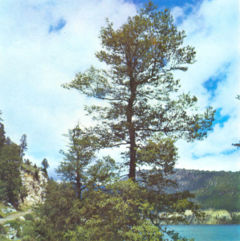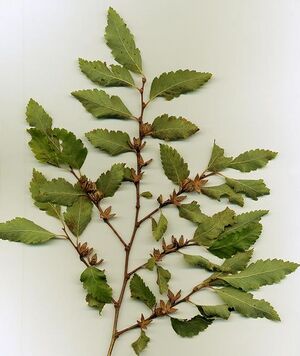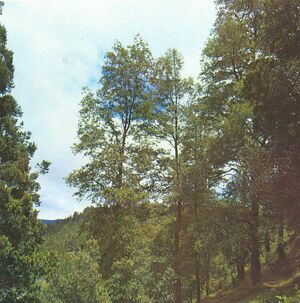Nothofagus: Difference between revisions
No edit summary |
No edit summary |
||
| Line 1: | Line 1: | ||
{{SPlantbox | |||
|genus=Nothofagus | |||
|Temp Metric=°F | |||
|jumpin=If this plant info box on watering; zones; height; etc. is mostly empty you can click on the edit tab and fill in the blanks! | |||
|image=Upload.png | |||
|image_width=240 | |||
}} | |||
{{Inc| | |||
Nothofagus (Greek words, meaning not a true beech). Fagaceae. A genus of about 12 species, native of S. Amer., Austral, and New Zeal., closely allied to Fagus, but chiefly distinguished by the fls., both staminate and pistillate ones being borne in 3's or solitary. The lvs. are generally small, often evergreen and cither plicate in bud, like those of Fagus, or not. The wood of some species, especially that of N. Dombeyi and N. procera, in Chile, and of N. Cunninghamii, in Austral, is much valued. They are not hardy in the N., and but little known in cult. The two following species have been recently intro. by the Dent, of Agric. N. obliqua, Blume (Fagus obliqua, Mirb.). Deciduous tree, attaining 100 ft.: young branchlets glabrous: Lvs. ovate-oblong, acutish or obtuse, oblique at the base, serrate, lobulate below the middle, glabrous or nearly so, with 8-11 pairs of veins, 1-2½ in. lone: involucre 4-valved: nuts 3, 2 triangular and 3-winged, 1 flattened and 2-winged. Chile. N. procera, Oerst. (Fogus procera, Poepp. & Endl.). Similar to the preceding: Lvs. oblong, rounded at both ends, doubly crenate-serrate, pubescent beneath, up to 4 in. long. Chile.—The following 6 species have been intro. into European gardens and have proved fairly hardy in S. England and Ireland. N. antarctica, Oerst. (B.M. 8314, var. uliginosa. J.H. S. 37:53), N. betuloides, Oerst. (G.C. 1872: 467; 11.25:105; 111.33:11), N. Cunninghamii, Oerst. (B.M. 8584), N. cliffortoides, Oerst., N. fusca, Oerst., and N. Moorei, Krasser. They are all trees or sometimes shrubby, with small, ovate or elliptic crenate-dentate Lvs., ½-1 in. long. The first one is deciduous, the others evergreen. They are perhaps oftener enumerated under Fagus, but besides the difference in the fls. they are different in habit, especially on account of their very small Lvs., large only in N. procera. Prop, is by seeds or by layers. | |||
}} | |||
{{Taxobox | {{Taxobox | ||
| color = lightgreen | | color = lightgreen | ||
Revision as of 09:40, 19 February 2010
| Nothofagus subsp. var. | ||||||||||||||||||||||||||||||||||||||||||||||||||||||||
|---|---|---|---|---|---|---|---|---|---|---|---|---|---|---|---|---|---|---|---|---|---|---|---|---|---|---|---|---|---|---|---|---|---|---|---|---|---|---|---|---|---|---|---|---|---|---|---|---|---|---|---|---|---|---|---|---|

|
|
| ||||||||||||||||||||||||||||||||||||||||||||||||||||||
| ||||||||||||||||||||||||||||||||||||||||||||||||||||||||
| Standard Cyclopedia of Horticulture |
|---|
|
Nothofagus (Greek words, meaning not a true beech). Fagaceae. A genus of about 12 species, native of S. Amer., Austral, and New Zeal., closely allied to Fagus, but chiefly distinguished by the fls., both staminate and pistillate ones being borne in 3's or solitary. The lvs. are generally small, often evergreen and cither plicate in bud, like those of Fagus, or not. The wood of some species, especially that of N. Dombeyi and N. procera, in Chile, and of N. Cunninghamii, in Austral, is much valued. They are not hardy in the N., and but little known in cult. The two following species have been recently intro. by the Dent, of Agric. N. obliqua, Blume (Fagus obliqua, Mirb.). Deciduous tree, attaining 100 ft.: young branchlets glabrous: Lvs. ovate-oblong, acutish or obtuse, oblique at the base, serrate, lobulate below the middle, glabrous or nearly so, with 8-11 pairs of veins, 1-2½ in. lone: involucre 4-valved: nuts 3, 2 triangular and 3-winged, 1 flattened and 2-winged. Chile. N. procera, Oerst. (Fogus procera, Poepp. & Endl.). Similar to the preceding: Lvs. oblong, rounded at both ends, doubly crenate-serrate, pubescent beneath, up to 4 in. long. Chile.—The following 6 species have been intro. into European gardens and have proved fairly hardy in S. England and Ireland. N. antarctica, Oerst. (B.M. 8314, var. uliginosa. J.H. S. 37:53), N. betuloides, Oerst. (G.C. 1872: 467; 11.25:105; 111.33:11), N. Cunninghamii, Oerst. (B.M. 8584), N. cliffortoides, Oerst., N. fusca, Oerst., and N. Moorei, Krasser. They are all trees or sometimes shrubby, with small, ovate or elliptic crenate-dentate Lvs., ½-1 in. long. The first one is deciduous, the others evergreen. They are perhaps oftener enumerated under Fagus, but besides the difference in the fls. they are different in habit, especially on account of their very small Lvs., large only in N. procera. Prop, is by seeds or by layers.
|
| Nothofagus {{{status}}} Fossil range: {{{fossil_range}}}
| ||||||||||||||||||||||||||||||||||||||||||||||||||||||||||||||||||
|---|---|---|---|---|---|---|---|---|---|---|---|---|---|---|---|---|---|---|---|---|---|---|---|---|---|---|---|---|---|---|---|---|---|---|---|---|---|---|---|---|---|---|---|---|---|---|---|---|---|---|---|---|---|---|---|---|---|---|---|---|---|---|---|---|---|---|
 Nothofagus obliqua | ||||||||||||||||||||||||||||||||||||||||||||||||||||||||||||||||||
| Plant Info | ||||||||||||||||||||||||||||||||||||||||||||||||||||||||||||||||||
| ||||||||||||||||||||||||||||||||||||||||||||||||||||||||||||||||||
| Scientific classification | ||||||||||||||||||||||||||||||||||||||||||||||||||||||||||||||||||
| ||||||||||||||||||||||||||||||||||||||||||||||||||||||||||||||||||
| [[{{{diversity_link}}}|Diversity]] | ||||||||||||||||||||||||||||||||||||||||||||||||||||||||||||||||||
| {{{diversity}}} | ||||||||||||||||||||||||||||||||||||||||||||||||||||||||||||||||||
| Binomial name | ||||||||||||||||||||||||||||||||||||||||||||||||||||||||||||||||||
| {{{binomial}}} | ||||||||||||||||||||||||||||||||||||||||||||||||||||||||||||||||||
| Trinomial name | ||||||||||||||||||||||||||||||||||||||||||||||||||||||||||||||||||
| {{{trinomial}}} | ||||||||||||||||||||||||||||||||||||||||||||||||||||||||||||||||||
| Type Species | ||||||||||||||||||||||||||||||||||||||||||||||||||||||||||||||||||
| {{{type_species}}} | ||||||||||||||||||||||||||||||||||||||||||||||||||||||||||||||||||
| Species | ||||||||||||||||||||||||||||||||||||||||||||||||||||||||||||||||||
| See text | ||||||||||||||||||||||||||||||||||||||||||||||||||||||||||||||||||
| [[Image:{{{range_map}}}|{{{range_map_width}}}|]] | ||||||||||||||||||||||||||||||||||||||||||||||||||||||||||||||||||
| Synonyms | ||||||||||||||||||||||||||||||||||||||||||||||||||||||||||||||||||
| {{{synonyms}}} |


Nothofagus, also known as the southern beeches, is a genus of about 35 species of trees and shrubs native to the temperate oceanic to tropical Southern Hemisphere in southern South America (Chile, Argentina) and Australasia (east & southeast Australia, Tasmania, New Zealand, New Guinea and New Caledonia).
In the past they were included in the family Fagaceae, but genetic tests by the Angiosperm Phylogeny Group revealed them to be genetically distinct, and they are now included in a family their own, the Nothofagaceae.
The leaves are toothed or entire, evergreen or deciduous. The fruit is a small, flattened or triangular nut, borne in cupules containing 2-7 nuts.
Nothofagus species are used as food plants by the larva of hepialid moths of the genus Aenetus including A. eximia and A. virescens.
Taxonomy
The genus is classified in the following sections:[1]
- Sect. Brassospora (type Nothofagus brassi)
- Nothofagus aequilateralis (New Caledonia)
- Nothofagus balansae (New Caledonia)
- Nothofagus baumanniae (New Caledonia)
- Nothofagus brassii (New Guinea)
- Nothofagus carrii (New Guinea)
- Nothofagus codonandra (New Caledonia)
- Nothofagus crenata (New Guinea)
- Nothofagus discoidea (New Caledonia)
- Nothofagus flaviramea (New Guinea)
- Nothofagus grandis (New Guinea)
- Nothofagus nuda (New Guinea)
- Nothofagus perryi (New Guinea)
- Nothofagus pseudoresinosa (New Guinea)
- Nothofagus pullei (New Guinea)
- Nothofagus resinosa (New Guinea)
- Nothofagus rubra (New Guinea)
- Nothofagus starkenborghii (New Guinea)
- Nothofagus stylosa (New Guinea)
- Nothofagus womersleyi (New Guinea)
- Sect. Fuscospora (type Nothofagus fusca)
- Nothofagus alessandri (Central Chile)
- Nothofagus fusca (New Zealand)
- Nothofagus gunnii (Australia: Tasmania)
- Nothofagus solandri (New Zealand)
- Nothofagus truncata (New Zealand)
- Sect. Lophozonia (type Nothofagus menziesii)
- Nothofagus alpina (=N. procera) (Central Chile)
- Nothofagus cunninghamii (Australia: Victoria, New South Wales, Tasmania)
- Nothofagus glauca (Central Chile)
- Nothofagus macrocarpa (Central Chile)
- Nothofagus menziesii (New Zealand)
- Nothofagus moorei (Australia: New South Wales, Queensland)
- Nothofagus obliqua (South America)
- Sect. Nothofagus (type Nothofagus antarctica)
- Nothofagus antarctica (South America)
- Nothofagus betuloides (South America)
- Nothofagus dombeyi (Central Chile and Andean Patagonia)
- Nothofagus nitida (South America)
- Nothofagus pumilio (South America)
References
Template:Commons Template:Reflist
- ↑ Nothofagus website (in French)